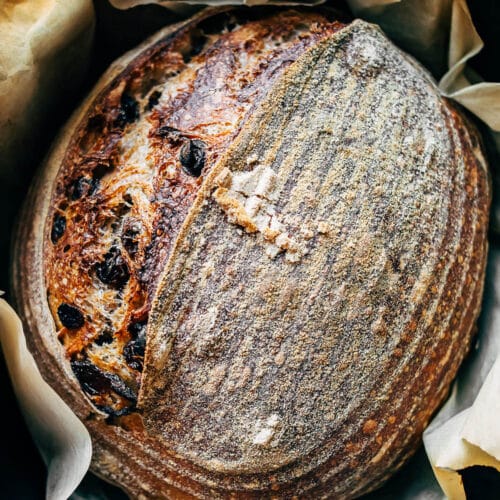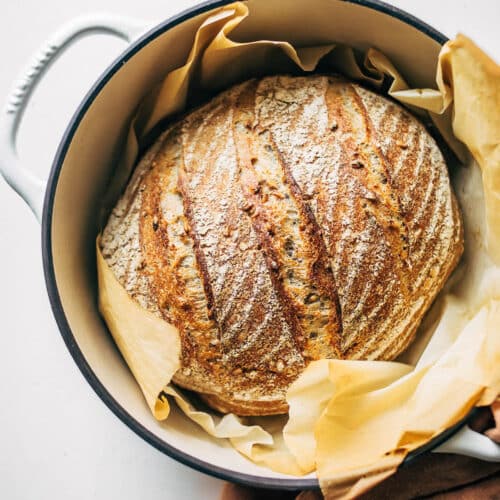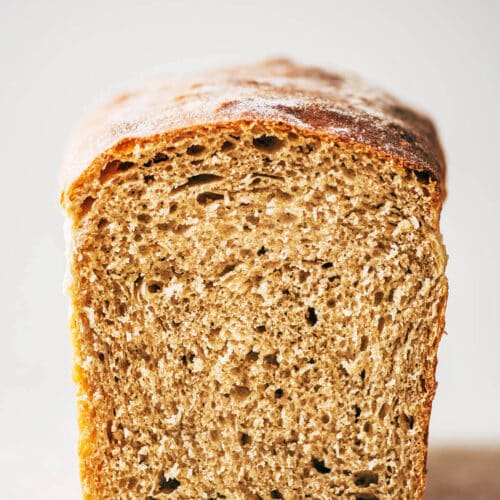Cranberry sourdough bread is a rustic, hearty loaf terrific for toasting or turkey sandwiches! With walnuts for added flavour and texture, this is a delicious twist on a basic sourdough, just right for fall baking.
For some more sourdough bread with flavourful add-ins, try our rosemary sourdough with black pepper, sourdough olive bread, and sweet cinnamon raisin sourdough.
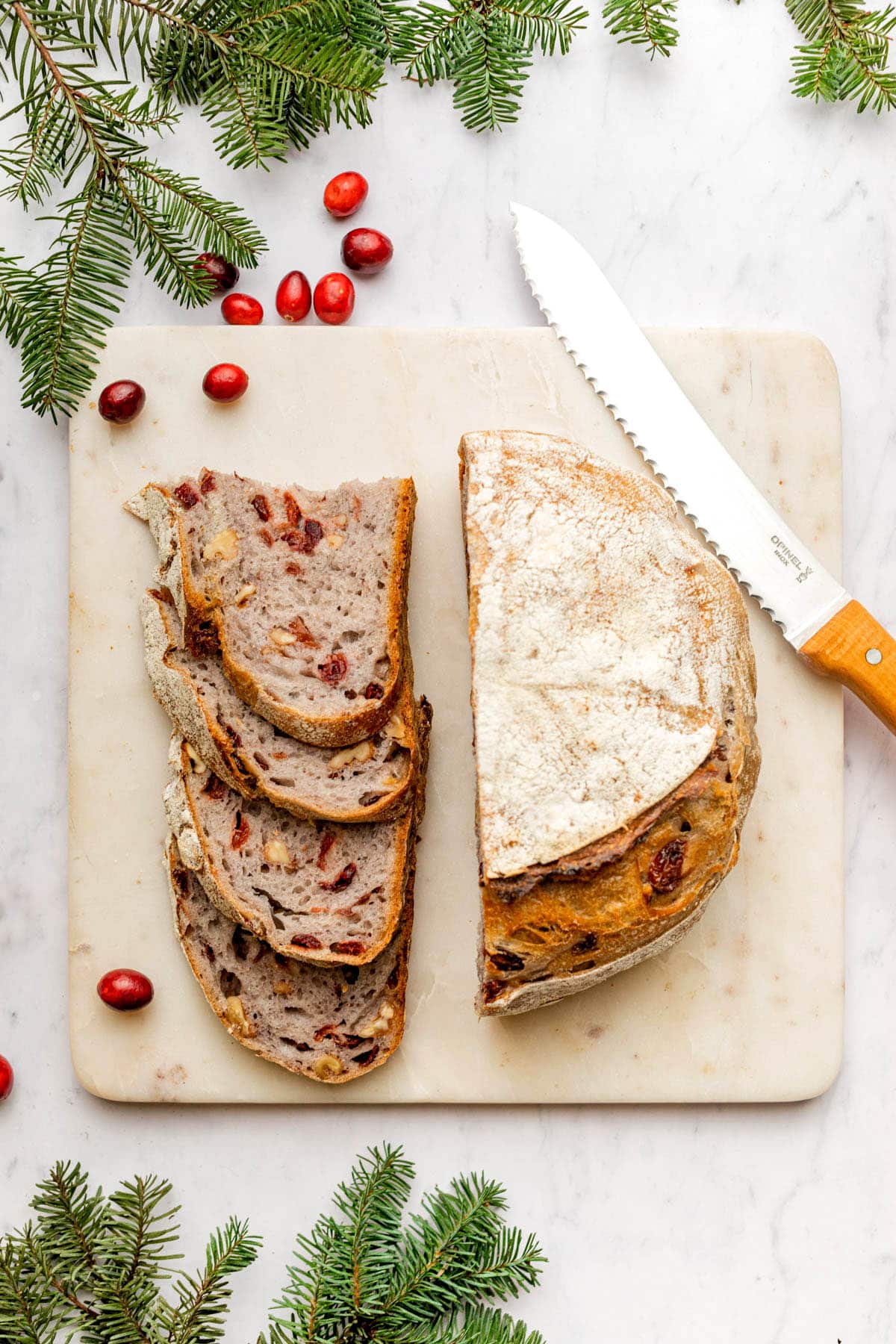
Jump to:
Ingredients

Ingredient Notes and Substitutions
- All-purpose flour: you can use bread flour (also called "strong" flour) in place of all-purpose. You can also substitute a portion of the all-purpose flour for whole wheat flour. Adding whole wheat will make for a denser crumb because it absorbs more water.
- Dried cranberries: substitute an equal amount of any dried fruit you like. Raisins, dates, and blueberries are all great options.
- Walnuts: use raw or (cooled) toasted walnuts. We also love pecans or a mixture of seeds like pumpkin and sunflower.
Method

Step 1: mix the starter or levain, flour, and water in a large bowl. Set aside to autolyse.
Step 2: Add the salt and use your hands to mix it in.
Step 3: add the walnuts and cranberries and mix to incorporate.
Step 4: do your stretches and folds.
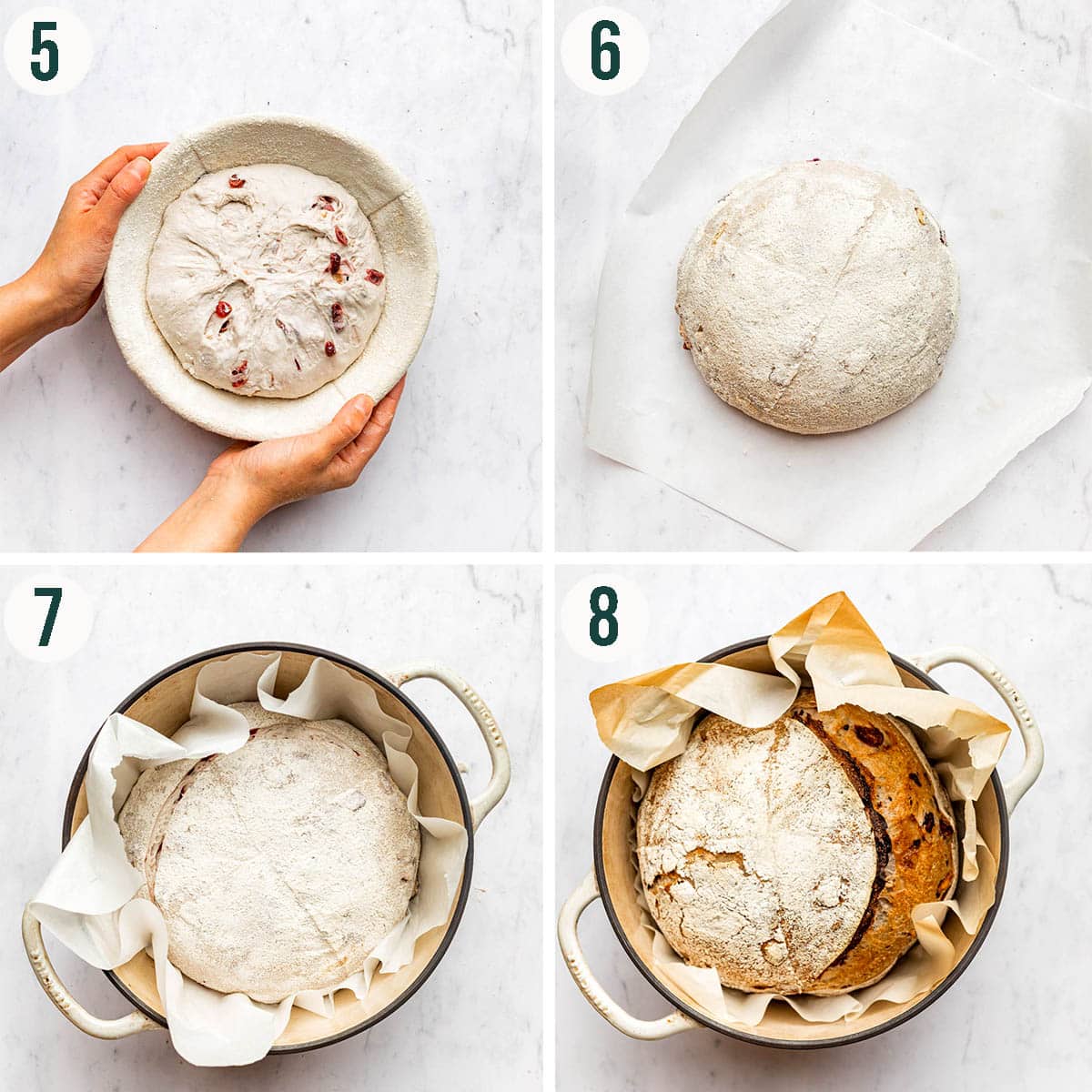
Step 5: form the dough into a boule and place into a prepared proving basket. Refrigerate overnight.
Step 6: turn the risen dough out onto a piece of parchment paper and score.
Step 7: place the dough into a pre-heated dutch oven.
Step 8: bake for about 40 minutes and cool before slicing.
Top Tips
- Cool in the pot: if heat makes it too difficult to safely remove the final loaf and parchment layer, let the loaf cool directly in the Dutch oven. Don't risk burning yourself.
- Start with the basics: we have a post called How To Shape Sourdough Boules if you are new to the concept. When shaping, aim for as much surface tension as possible without tearing the outside of the loaf.
- Chop into smaller pieces: slice the cranberries and walnuts into smaller pieces before adding them to the dough if you want. This can make it a little easier to shape the loaf.
- Skip the levain: if you don't want to add an extra day to the baking schedule, simply use an equal amount of active sourdough starter if it's already fed and ready go to.
Recipe Notes
You can use a medium-sized mixing bowl lined with a tea towel if you don't own a banneton. Be sure to dust the tea towel in the bowl generously with flour before placing the dough inside. Flour makes it easier to lift the dough away from the fabric.
A cast iron Dutch oven works best and can be enamelled or un-enamelled. We prefer cast iron for its even heat distribution and retention.
Walnuts can sometimes react to bread dough and turn an almost purple colour. It can look off-putting but is totally safe to eat.
How to Store
Storage: keep cooled bread in a paper bag, wrapped in a tea towel, or with the cut-end wrapped in beeswax wrap. If you have a bread bin, that's a great option too.
Freezing: freeze the fully cooled loaf whole, very well wrapped, or freeze individual slices in an airtight container (we recommend the latter). The slices are easy to thaw right in the toaster.
FAQ
Why is sourdough bread better for you?
Sourdough bread uses wild yeast rather than commercial and, as a result, needs a much longer fermentation period. This makes it easier to digest for most people.
What makes sourdough bread different?
The main difference between sourdough and other bread is that it sits for longer before it's baked. Because the starter is fermented flour and water, it kickstarts a fermentation process in the bread, too, and that process goes on for longer than it does with yeast.
Can you toast sourdough bread?
Of course you can toast sourdough! Toasted sourdough bread is one of the best ways to enjoy it, spread with a little butter or any other topping you like.
If you make this Cranberry Walnut Sourdough Bread recipe or any other sourdough bread recipes on the Baked Collective, please take a moment to rate the recipe and leave a comment below. It’s such a help to others who want to try the recipe. For more baking, follow along on Instagram, TikTok, and YouTube.
Cranberry Sourdough Bread With Walnuts
Equipment
- 2 Mixing bowls
- Tea towel
- Banneton
- Dutch oven
- Parchment paper
- Wire rack
Ingredients
- 100 grams levain made the night before (see instructions)
- 500 grams all-purpose flour
- 375 grams water room temperature
- 10 grams sea salt
- 100 grams dried sweetened cranberries
- 80 grams shelled raw walnuts
Instructions
DAY 1: Make The Levain
- Make a levain the night before you want to start your loaf. Alternatively, use bubbly active sourdough starter and skip straight to day 2.
DAY 2: Make & Shape The Dough
- Combine the all-purpose flour and the water in a large mixing bowl. Add the levain (or an equal amount of bubbly active sourdough starter) to the bowl. Use your hands to mix the ingredients into a rough shaggy dough. Once the dough is mixed, cover the bowl with a tea towel. Let the dough sit at room temperature for 30 minutes to rest.
- While the dough is resting, place the cranberries and walnuts in a second bowl. Cover them with hot tap water, poured about one inch above the top of the berries and nuts. Set aside to soak.
- After the 30 minute resting time has elapsed, sprinkle a bit of salt over the dough. Use your hands to mix the dough around, gradually adding more salt, until the salt is gone and is well distributed throughout the dough.
- Drain the cranberries and walnuts, discarding the soaking liquid. Add them to the dough, and again, use your hands to mix them in.
- Do the stretch and folds: Dampen your hands lightly with water. Reach under the dough on the opposite side of the bowl from you. Gently pull the dough up, stretching it as far as you can without tearing it. Once you have stretched it as far as you can, fold the dough over in half, on top of itself, back into the bowl. Turn the bowl a quarter turn and repeat the process on all four quadrants of the bowl. This completes one series of stretch and folds. Do six more series of stretch and folds, one every 30 minutes, for a total of 3 hours.
- Shape the dough: Dust a work surface with flour. and lightly dampen your hands. Reach into the bowl and underneath the dough, gently scooping it and coaxing it out onto the work surface. Let the dough rest for 20 minutes. While the dough is resting, prepare a banneton by dusting the inside liberally with flour (we like a mix of wheat flour and rice flour).
- After 20 minutes, shape your loaf. When shaping, aim for as much surface tension as possible over the loaf without tearing the outside of it.
- Once shaped, turn the loaf into your prepared banneton with the top of the loaf facing down and the bottom seam facing up. Sprinkle a bit of flour on the exposed dough before covering it gently with a tea towel. Place the loaf in the fridge overnight.
DAY 3: Bake Your Loaf
- Place a Dutch oven, with the lid on, into the oven. Preheat the oven to 500°F (260°C) (if your oven doesn’t reach 500ºF, preheat it at the highest temperature available). Once the oven has come to temperature, continue to preheat the Dutch oven for another 30 minutes.
- Have a large square sheet of parchment paper ready and remove your bread from the fridge. Gently invert the dough onto the parchment paper and lift away the banneton. If your bread is sticking, give it a few occasional gentle shakes until it releases.
- Gently score the bread with a sharp blade in any pattern you like. Using oven mitts, carefully remove the Dutch oven from the oven. Remove the lid, then carefully lift the dough into the hot pot using the parchment paper as “handles”. Again, using oven mitts, carefully place the lid back on the Dutch oven, then put the whole pot back into the heated oven.
- Reduce the oven temperature to 450°F (230°C) and bake the bread for 20 minutes. Wearing oven mitts, remove the pot from the oven. Carefully remove the lid (be careful of steam) and bake the loaf for another 22 to 25 minutes with the lid off.
- Remove the pot from the oven. Carefully lift the loaf out of the pot using the edges of the parchment paper and set it on a wire cooling rack. Remove the parchment paper once it’s cool enough to do so, then leave the loaf on the rack to cool completely before slicing, about 5 to 6 hours.


